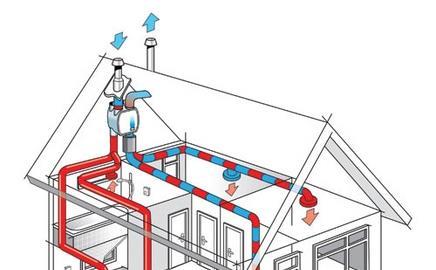The path to energy efficiency leads to well-sealed houses, but poor ventilation can cause a health hazard. Peter Caplehorn of Scott Brownrigg looks at whole-house solutions
The drive for more energy-efficient houses has caused a gradual improvement in the overall performance of an average dwelling’s fabric. Along with increases in insulation levels and higher U-values for windows, the last revision to the Building Regulations saw a change from a preferred air leakage rate to a limit state value. This recognises that leaky buildings are inefficient and even moderate air flows can have a very significant effect on overall performance. A very well sealed house with good insulation needs remarkably little in the way of additional heating and, in the race to create zero-carbon homes, makes a significant contribution.
However, a completely sealed house has the potential to become unpleasant to live in. While ventilation needs to be provided, other issues such as cooking odours and condensation from washing and cleaning also need to be addressed. It is therefore important that, in combination with the well-sealed house, some form of controlled ventilation should be installed.
1 What are the options?
At a very basic level, ventilation can be achieved by incorporating a range of devices into the windows and perhaps some mechanical extract for the kitchen and bathroom area. However, these devices are designed to allow the householder to control whether or not they are used and this can soon lead to either too much air flow, thus increasing energy consumption, or too little, resulting in poor air quality.
One increasingly popular solution is the use of a whole-house ventilation system. These have been featured in exhibition homes for some time, but tried and tested units with known installation principles are now available and are easy to install.
2 What to consider at the design stage
For a new-build project there are several types of whole-house ventilation systems to consider. The appropriate choice will depend on the size of the dwelling, the construction type, the availability of outside walls and the overall energy concept.
It is also important to ensure the ducts and vents are integrated within the overall design. Especially with a passive stack ventilation system, a minimum deviation from a straight line in the ductwork is required for optimum performance.
Intake vents should be integrated where possible, as part of the window design or adjacent to the window openings. Special consideration also needs to be given to open fires and appliances that need air supplies. Special attention should be given to separate supplies and extracts for solid fuel fires. Remember, open chimneys and vents are not compatible with whole house ventilation.
Applying a whole-house ventilation system to an existing building can be challenging. Rarely, and unless a great deal of refurbishment takes place, can the ducts and vents be easily integrated. However, unused chimneys can sometimes be suitable, and old buildings often have thick walls or hidden cavities that can, with care, also be used.
3 The type of systems available
The simplest form of whole-house ventilation system uses individual inlet vents and an integrated passive stack to vent the stale air. This depends solely on the stack effect of warm air rising and drawing air through the rooms to the outside. Once installed, this type of system needs only occasional cleaning and uses no energy. However, the effectiveness depends on a good thermal gradient and can be of limited effect in some weather conditions.
Attaching a fan to these systems can add greatly to the effectiveness and also introduces a degree of either automatic or manual control. Energy will, of course, be required to run the fan. It is possible to combine the two concepts but the fan should be located in a parallel duct to avoid adding resistance to the passive system.
In recent years, we have seen the emergence of dedicated whole-house ventilation units. These come in a range of sizes and are designed to be located in the loft space. They have a number of simple connections but provide both the intake and extract control. This has several advantages. Firstly, air brought into and sent out of the home can be controlled accurately. Secondly, they nearly all contain a mechanism to capture heat from the extract air, so reducing the amount of energy needed to heat incoming fresh air. Thirdly, they can have a pollen and dust filter system which is especially useful for those sensitive to airborne irritants.
4 Installation and commissioning
Whatever the type of system being installed, it needs to be fitted and commissioned before the occupants move in. All the ducts must be sealed and airtight as should the penetrations through the external envelope. External intake and extract grills should face away from prevailing winds and any local issues such as neighbour boiler flues
If a fan system is installed, it should run with as little noise and vibration as possible. Remember that the system may need to run at night and must not disturb the occupants. The occupants will rely on the air supply system for their good health, so it is critical that it performs and delivers the fresh air as needed on a consistent basis.
Regular maintenance needs should be made clear. The ducts and shafts must be cleaned, preferably at least every two years, and fans and filters checked. Filters need to be changed in strict accordance with the manufacturer’s recommendations.




























No comments yet